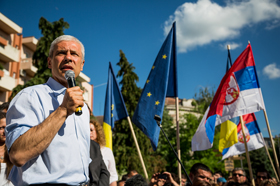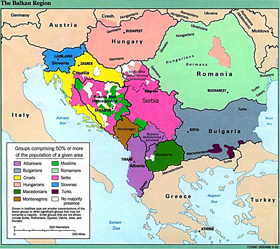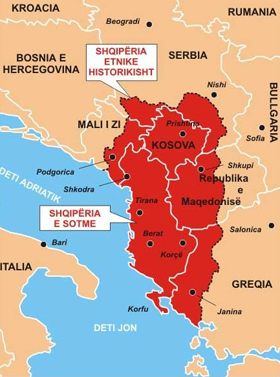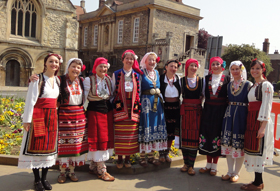When Will Europe’s Powder Keg Explode?
Battle of Kresna Gorge, 1913
In
Login if you are already registered
(no votes) |
(0 votes) |
PhD in History, Deputy Dean of the MGIMO University
A hundred years ago today the first Balkan War was raging. Their war ended swiftly and victoriously, and few in Europe could have expected that, less a month later, having failed to agree on the borders, the winners would launch a new, internecine, conflict. The region has often been referred to as Europe’s powder keg. What many would like to know is whether there are any signs that this keg will be set off in the 21st century, and if so, when?
A hundred years ago today the first Balkan War was raging. A union of newly independent Bulgaria, Greece, Serbia and Montenegro were fighting the Ottoman Empire for lands they had lost to it five centuries before. Their war ended swiftly and victoriously, and few in Europe could have expected that, less a month later, having failed to agree on the borders, the winners would launch a new, internecine, conflict. The war’s outcome divided former allies: they found themselves on different sides of the barricades during the two world wars, and paid put to Russia’s almost 150 year old dream of establishing a union of Christian Orthodox states in the Balkans. The region has often been referred to as Europe’s powder keg. What many would like to know is whether there are any signs that this keg will be set off in the 21st century, and if so, when?
The Balkans has always been in conflict, and there are two main reasons for this. First comes the motley collection of historically overlapping ethnicities, cultures and religions. In terms of the sheer number of peoples and ethnicities in a limited territory, the Balkans can probably only be compared to the Caucasus. A region with an area that is just one twentieth of that of Europe is home to one quarter of all European states [1]. Besides, the rather belated process by which these nations acquired their sovereignty was quite uneven. The case of the former-Yugoslavia seems to suggest this process may still be ongoing.
Another reason is that the Balkans, as a location, has high geopolitical significance, at the crossroads of routes from Europe to Asia and Africa. For centuries these crossroads were fought over, and the great powers set their borders as was in their best interests. The 1995 Dayton Accord, which drew a line under the Yugoslav war, or the outcome of the Kosovo conflict were no exception. All the Balkan crises had their own causes, but they were particularly exacerbated by foreign intervention.
As a result, there is not a single border in the Balkans that can be called “fair” or “perfect.” Almost any Balkan country, with the probable exception of Slovenia, has territorial claims to one or several of their neighbors. Any of these disputes, of which there are about 30 in total, could spread beyond the region in an attempt to change these borders.
Ideas of a greater Albania, greater Bulgaria, greater Greece or greater Serbia are often bandied about. The closest they have yet come to reality with that of a greater Albania, which would not just split Kosovo off from Serbia, but also take parts of Macedonia, Greece and Montenegro with large Albanian populations.
No current list of reciprocal territorial claims has been officially released, and “unfair borders” are discussed mostly by “public and academic communities.” However, both world wars had plentiful examples of how seemingly crazy and marginal ideas could be turned into a very bloody reality.
The external conflict potential is amplified by internal political and socio-economic instability. It was no accident that the financial and economic crisis in the EU started in the Balkans, with Greece.
Balkan instability has both internal and external dimensions. Aware of the highly tense situation in the region, many major world players, playing the “great chess board”, might see this as an opportunity to exploit Europe’s “weak spot.” According to one well-argued point of view, the 1999 Kosovo crisis was merely a well-played economic move to contain the single European currency. This century the external factors will continue to be vital in relations among Balkan countries.
War: As An Extension of Demographics
The Balkans is also is an area of demographic instability. There are a few cases of an initially small ethnic minority growing significantly within decades – changing the ethnic composition of a state and then demanding autonomy. This was how the fate of Transylvania was decided150 years ago: the Romanian population grew faster than that of the Hungarians or Germans.
Thus, one can argue that Kosovo’s independence was decided less by rebels or politicians, and much more by Kosovar women. While in 1953, Serbian women had on average 5.9 children (each) and Albanian women had on overage 6.3 (each), in 1991 they had 2.8 and 6.2, respectively, with this latter currently the highest figure in Europe.
Balkan Muslims today show the highest rate of population growth. Christians in the Balkans are forecast to further demographic decline due to labor migration to West Europe and their lower birth rate. In the Central and East European countries, the birth rate, according to some estimates, is expected to reach 1.1 – 1.3 children per woman by 2050.
Some estimates suggesting that the growth rate of the Muslim population in the region will tail off by mid-century, and is not expected to exceed 14 per cent. However, today we see an ongoing process of political consolidation among Balkan Muslims, and Islamic radicalization is present in the peninsula’s most crucial hot spots. In the last decade both Kosovo and Bosnia-Herzegovina (BiH) have been actively infiltrated by Wahhabism from Saudi Arabia.
The demographic time-bombs ticking away in the Balkans are likely to go off by mid-century, if not in the coming decade, causing more changes to the borders.
NATO’s Stick and EU’s Carrot
One can reasonably ask: are there any stabilizing factors in the Balkans? The answer is clear: there are – and the key one is integration.

This EU “bait” brought Boris Tadic to power in
Serbia, forced him to cooperate with the
International Tribunal on Former Yugoslavia and
make the first steps to accommodate Pristina
Historically, the Balkans boasted the most stable internal borders when the region’s sovereignty was limited. The Balkan states were presented with a package-deal under the idea of European and Euro-Atlantic integration. They would forfeit some of their national sovereignty – in exchange for enhanced prospects for economic prosperity and border security. Initially this played a positive role in the Balkans: the EU was unwilling to import new disputes with their new members. This EU “bait” brought Boris Tadic to power in Serbia, forced him to cooperate with the International Tribunal on Former Yugoslavia and make the first steps to accommodate Pristina.
However, integration with NATO and the EU is no magic bullet, nor does it guarantee prosperity. As Konstantin Nikiforov, director of the Russian Academy of Sciences’ Institute for Slavonic studies, aptly said, “in this elite club, some drink whisky and some wash the plates”. Rivalries between countries remain after accession, as the Greece/Turkey case shows. Besides, the likelihood of the western Balkans [2] being allowed into the EU remains slim. In the wake of the 2008 economic crisis, Brussels has increasingly questioned whether the decision to include the relatively stable states of Romania and Bulgaria had been made too hastily.
The slower EU accession process in the Balkans will certainly threaten the stability of the peninsula’s borders. By supporting Kosovo’s independence, the West has set a dangerous precedent, not just for the region itself, but for Europe as a whole. The Second World War leaves us a powerful lesson about the potential dangers of appeasement. And then EU itself has rather unclear prospects in the longer term. The US National Intelligence Council’s report “Global Trends 2025” highlights Brussels’ position as favorable to promoting political stability along Europe’s periphery while also not excluding the possibility that the EU could become “a hobbled giant” by 2020–2030 should the integration processes slow.
Post-Fukuyama, Post-Huntington Scenarios
Many Western political scientists view the possible scenarios for the Balkans schematically: either celebrating the victory of the liberal model, with democracy and European integration (“after Fukuyama”), or a clash of cultures and civilizations at their crossing points, i.e. the Balkans (“after Huntington”).

By supporting Kosovo’s independence, the West
has set a dangerous precedent, not just for the
region itself, but for Europe as a whole
Is the former, optimistic, EU scenario still possible? Say the EU is lucky enough to survive the next wave of the economic crisis, tackle the outsiders’ issues and hand out significant funds to bankroll the next phase of enlargement. Say the Balkan countries are prepared to wait another 10 or 15 years, using this time to resolve their mutual disputes. Assuming that Serbia recognizes Kosovo’s de jure secession. Then, with borders becoming increasingly transparent, and national minorities seeing their rights upheld, there is no longer any case for the Albanians’ ambitions to unite within a single state. The Muslims in the region will complete their demographic transition, and the rates of population growth across the countries will level off. Turkey will renounce its neo-Ottoman policies in the region, while Saudi Arabia will stop backing Islamic extremism. Who, then, would be willing to light the fuse of Europe’s “powder keg”? Only if all these conditions are satisfied would internal borders in the region stay intact. That is clearly unlikely.
If European integration slows, or there is a serious economic crisis, then a different scenario seems more likely. The western Balkans, with the exception of Croatia that has made it into the EU, will enter economic decline. Greece will be punished for its “sins” with expulsion, followed by Romania and Bulgaria. Serbia will refuse to recognize Kosovo’s independence. Without seeking anybody’s permission, Pristina and Tirana will work together to create a greater Albania, first through Anschluss with Kosovo, and then by grabbing Serbian, Montenegrin and Macedonian lands. The Republic of Srpska, in turn, will announce its union with Serbia and Bosnia and Herzegovina will cease to be an independent state. Bosnian Muslims propose a union with Muslims in Pristina and Tirana. Then the continent will be just a short step remains from a Muslim state in the Balkans emerging under Turkish patronage.
NATO will intervene, peacekeeping forces will watch over an exodus of Serb and Macedonian civilians from the conflict zones. This will all unfold alongside armed clashes, mass casualties and migration flows. An international conference will be called to prevent the conflict, naturally without Russia’s involvement, held outside the UN aegis. The conference will establish new legal borders – creating a greater Albania (or even Balkan Caliphate), largely at the Serbs’ expense. The remnants of Macedonia, with NATO’s consent, will be divided between Greece and Bulgaria. Montenegro will decide to return to their union with Serbia, but the two countries will be separated by a Muslim corridor ingeniously created by the US. The Balkans will have been appeased for the time being, but all parties involved will be preparing for revenge.
What next? A war by all against all? Classic balkanization? No, what will follow is another integration, but a particular, Balkan one.
A Federation of Balkan States or a New Ottoman Empire?
Along with internal squabbling and the search for a powerful patron, from the first day of their independence, Balkan countries had been learning how to cooperate within the region. In fact, the Balkan countries have a lot of experience to share, including regarding economic order, common issues and conceptual approach. The 19th century’s ideas of “Yugoslavism” did not materialize from nothing. With European integration slowing, the Balkan countries would be pushed to look for other alternatives. They might pursue a course of regional integration similar to that of the EU, and consolidate into a Balkan Federation (possibly even socialist).
This was first heralded by the idea of a Balkan Benelux, to include Albania, Kosovo, Macedonia and Montenegro, with the free movement of goods, services, capital and people. Familiar reasons, such as issues with EU accession mean that, the proposed plan’s authors say, this will drag out till 2030.
Importantly, alliance projects in the Balkans had always been externally led, be it from Constantinople, Istanbul, St Petersburg, Moscow or Brussels. If these latter withdraw their patronage, there will always be other willing parties. While Moscow might have had its fill of “Balkan unions,” Ankara has formulated its neo-Ottoman doctrine and declared the Balkans as among its foreign policy priorities. This all makes good fuel for future-scenario planners’ fantasies.
The revival of the Sublime Porte is unlikely any time soon. Trade, economic and cultural penetration of the region, and support for Muslims are their focus of attention. However, in a couple of decades’ time, particularly in the event of an EU crisis, the Balkan nations, tired of internal vicissitudes and interstate disputes, may be only glad to be conquered. In the event that Ankara supplants Brussels with an adequate integration project, emphasizing regional issues, the revival of a new Ottoman Empire with its capital in Istanbul (which could even be renamed Constantinople) would not seem that incredible. However, before this transpires, the Turkish leadership will have to choose to back a joint Balkan integration project instead of only supporting the Muslim communities in the peninsula. In binding themselves too closely with the latter Turkey would run the risk of engendering yet another national liberation movement and in turn once again raising the “Eastern Issue” in Russia’s foreign policy. What goes around comes around. Anything is possible in the Balkans.
It is extremely hard to predict what borders in the Balkans will be like in a hundred years’ time. Only one thing is clear: these borders will change. Even hardened EU optimists won’t argue with that. The region’s conflict potential is too high. However, despite all the mistakes that the West has so far made in the Balkans, they have come up with a magnificent project of a single Europe. Should it be implemented, the region’s conflict potential would be significantly reduced, and the border issue will no longer be relevant. Here the proof lies in the project: it must not become yet another myth, like the “Byzantine legacy”, the “Union of Orthodox Christian Nations”, “Yugoslavism”, or “Socialist Community”.
After they ended, there was always another upsurge in conflict in the region. The destiny of the Balkans yet again depends on decisions taken by the “high and mighty.”
1. Geographically the Balkan nations include Albania, Bulgaria, Bosnia-Herzegovina, Greece, Macedonia, Romania, Serbia, Slovenia, Turkey, Croatia and Montenegro. However, Romania and Slovenia are only partly located in the Balkan Peninsula, and try to position themselves as Central European countries. Expert communities meanwhile tend to include them with the Balkans in political and economic terms.
2. The term “western Balkans” is a relatively new term taken up by Brussels to distinguish the EU integration outsiders: Serbia, Croatia, Montenegro, Bosnia-Herzegovina, Macedonia and Albania.
(no votes) |
(0 votes) |







